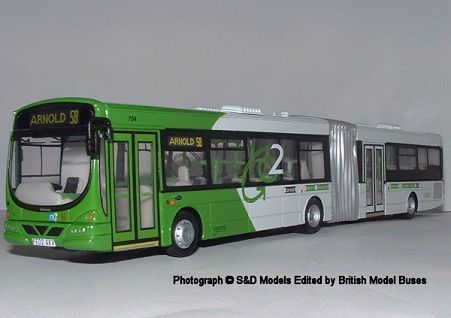|
OM41302
OOC Scania Wright Solar Fusion Review
By
Mark Smith
It’s
not everyday that Corgi bring out a model of a vehicle that I have actually
driven, let alone only driven once. But
so it transpires, for in March 2003 Ipswich Buses borrowed Nottingham 704
(FE02 AKV) for the day, and along with a few lucky others, I was allowed to
play with this mighty vehicle for a while.
So as you can imagine, being able to review the model of it is
something of a privilege.
The
OOC catalogue for 2004 revealed two Scania models (this and the Go North
East version), which depict the Wrightbus body on Scania L94UA chassis (the
Solar Fusion), and the forthcoming First versions on the Volvo B7LA chassis
option (the Eclipse Fusion). The
basic body difference between Eclipse and Solar is the door position on the
rear half of the bus – on the Scania (Solar) there is a small window ahead
of the doors, whereas the doors are ahead all the windows on the Eclipse. More on that detail in a minute!
First
impressions compare well with the real thing.
Without drawings, it is not possible to comment on dimensional
accuracy but the proportions of the vehicle look correct. The shades of the NCT ‘Go 2’ livery mirror those of the
real thing, as does the overall rear advert, which is common on real buses
but less so on models. This
adds to the realism in my view. The
articulated section (which does not ‘pose’ in articulation but does bend
to some degree) is the correct silver grey shade, but is obviously
dimensionally compromised with too few ribs, and without the characteristic
central divider in the ‘bellows’. The
grey based interior has a good representation of cab door, complete with
circular door and ‘W’ logo, and the green internal grab poles and exit
barriers to the rear door. The
seat bases are colour contrasting in black.
Separate mirrors and wipers complete the ensemble.
The
printed livery detail is generally accurate and in the right place, although
some of the finer details (wheelchair logo by the front door for example)
are not depicted. The front
number plate is poorly proportioned and the ‘push to open’ circular
logos (present on the rear doors) are missing at the front.
Bizarrely, the exit door barriers, which as mentioned above are
depicted internally as separate fittings, are also printed on the doors as
well! For me this is a minor
disappointment, but better research and checking of the prototype could
avoid these annoying errors. Overall, the model looks like the real thing, which is
excellent, as I suspect this is not an easy livery to recreate, given the
lively shades of colour and the arc of the green colour.
But
for me, there is one big disappointment.
The rear exit door on the back half of the bus is in the wrong place
– Corgi has elected to use one variant of the casting so a ‘Solar’ is
actually an ‘Eclipse’ in disguise.
To be fair, this intention was stated before the model appeared, but
the mock ups in the catalogue suggested we might just get a ‘real’
Scania version with the door in the right place.
I can understand the logic behind the decision (presumably to
minimise tooling costs) but for me, it detracts from the finished result.
Fortunately the offside suffers from no such problems and looks
superb as a result.
Overall
though – for £25 plus one expects a lot for a model nowadays – and this
one, while good, misses out on top marks.
A bit more printed detail, colour to the interior, (the seats are
quite a vivid pink moquette, not black!), poseable articulation and moving
that rear door would have made all the difference.
With 4100 of this version made, I don’t think getting hold of one
will be a problem. Nevertheless,
for me it’s a fine reminder of the hour or so I had driving this
head-turning bus in my home town (regrettably after the demonstration we
ended up with more East Lancs bodied Transbus Darts, but that’s another
story!). Gareth has kindly
posted a couple of pictures of the real thing in the gallery pages, so you
can compare the model with the real thing.
Review © Mark Smith December
2004
|

